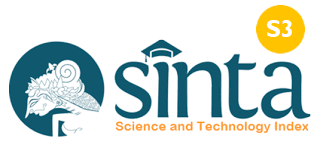Esensi Rerajahan Yama Raja Pada Upacara Usaba Manggung Aci Sumbu Di Desa Bugbug Karangasem Perspektif Pendidikan Seni Rupa Hindu
Keywords:
Essence, Yama Raja, Hindu TheologyAbstract
Rerajahan is a religious Hindu fine art in the usaba manggung aci sumbu ceremony for Bugbug village people in Karangasem. The form of rerajahan made is known as Yamaraja. It is very interesting to be researched in Hindu fine art theology perspective, with problem: how is the procession of making rerajahan Yamaraja at Usaba Manggung Aci Sumbu ceremony in Bugbug village, how is the essence of rerajahan Yamaraja, how is the form of rerajahan Yamaraja in theology perspective of Hindu fine art in Bugbug village Karangasem. This research is aimed to develop the Hindu based scientific studies and as contribution of teaching material om Fine Art Education and Hindu Ornament study program of UNHI. The theory used in this research is sacred theory that discuss the procession problem in making rerajahan, symbol theory to discuss the essence in rerajahan, reasonable limit theory to discuss the form of rerajahan yamaraja in theology perspective of Hindu Fine Art. Research method used is qualitative method {Bogdan and Bien 1982} with object Rerajahan Yamaraja at Usaba Manggung Aci Sumbu ceremony in Bugbug village Karangasem, using Hindu Fine Art theology approach. The research location is Bugbug village Karangasem, descriptive qualitative data type according to the opinion og Bogdan and Bikleri 1982, with primary data sources in the form of interview with Bugbug village elders, secondary data in the form of books. Information technique uses purposive sampling, data collection through passive participation observation, unstructured interview, books documentation, photos and library study, data analysis technique in accordance with Milles Huberman 1992, and data validation technique by using triangulation method according to the opinion of Denkein. The result of procession analysis of rerajahan Yamaraja at Usaba Munggung Aci Sumbu ceremony started krama desa tedun, pewintenan, pecaruan, nyeket yamaraja,mubuh pamor,nyawi,pasupati pebantenan usaba manggung and rerejangan,bhetara tirte tedun,nunas tirte. from the essence consist of; release and harmonization. The form of rerajahan in Hindu Fine Art theology perspective: Manifestation of God, Manifestation of Butha, Manifestation of God Yama Raja
References
Boqdan H.R dan Biklen S.K.1982. Qualitative Research or Education A Introduction to teory and methods Boston allyn and balon inc .Jakarta;Universitas Indonnesia.
Bogdan dan Tylor, 1992. Analisis Data Penelitian Kualitatif Suatu Pendekatan Fenomonologis Terhadap Ilmu-Ilmu Sosial. Surabaya : Usaha Nasional.
Bhagavad Gita, Koleksi Dokumentasi Dinas Kebudayaan Propinsi Bali.
Titib, I Made, 1996. Veda, Sabda Suci, Pedoman Praktis Kehidupan. Surabaya : Paramita.
Titib, I Made, 2003. Purana Sumber Ajaran Agama Hindu Komprehensif. Jakarta : Pustaka Mitrajaya.
Titib, I Made, 2003. Teologi dan Simbol-simbol dalam Agama Hindu. Surabaya : Paramita.
Moleong, Lexy, 2001. Metodologi Penelitian Kualitatif, Bandung : PT Remaja Rosdakarya.
Milles Hubuman, 1992. Analisis Data Kualitatif. Jakarta : Unipersitas Indonesia.
Kitab Menawadharma Sastra, Koleksi Dokumentasi Dinas Kebudayaan Propinsi Bali.
Downloads
Published
How to Cite
Issue
Section
License
An author who publishes in the Cetta : Jurnal Ilmu Pendidikan agrees to the following terms:
- Author retains the copyright and grants the journal the right of first publication of the work simultaneously licensed under the Creative Commons Attribution-ShareAlike 4.0 License that allows others to share the work with an acknowledgement of the work's authorship and initial publication in this journal
- Author is able to enter into separate, additional contractual arrangements for the non-exclusive distribution of the journal's published version of the work (e.g., post it to an institutional repository or publish it in a book) with the acknowledgement of its initial publication in this journal.
- Author is permitted and encouraged to post his/her work online (e.g., in institutional repositories or on their website) prior to and during the submission process, as it can lead to productive exchanges, as well as earlier and greater citation of the published work (See The Effect of Open Access).
Read more about the Creative Commons Attribution-ShareAlike 4.0 Licence here: https://creativecommons.org/licenses/by-sa/4.0/.





